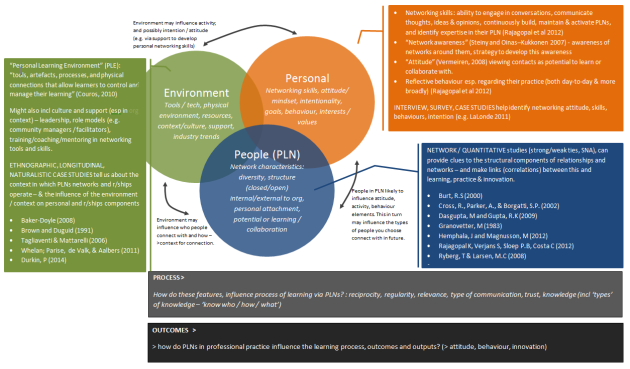I met with my supervisor a couple of weeks ago to get feedback on my research proposal. One of the most helpful suggestions he made was to tease out the factors from the literature that influence the usefulness of a network to achieve the desired outcome (i.e. improvements / innovations in professional practice) – and to develop a model based on this literature review. My research could then be used to explore / validate this model (and provide some structure to interviews and data analysis). So this is what I’ve been working on. Aside from the benefits this model will bring to structuring the research, the process of thinking in terms of a model has been extremely useful in helping me to consolidate the various (and disparate) strands of literature I’ve reviewed, and my thinking around it. This is my working draft.
As I tease out the strands of research three key components emerge for me as being relevant:
- Environment – a lot of research focuses on the ‘tools’ / tech that people use to build and develop networks. Whilst this is certainly interesting – as different tools have different affordances which support varying aspects of PLN relationship development – it’s more than just the discrete tools and tech that influence the development of these relationships. It’s the entire context in which the tools / tech are embedded and used – this includes the environmental & situational context (e.g. where is the tool/tech being used – work, home, the beach, etc?), culture (incl. organisational/industry/societal/geographical/national/political etc), and the support available to develop skills in the use of the tools/tech.
- Personal – these are the personal skills and characteristics that contribute to an individual’s decision and motivation to actively and intentionally build and maintain a PLN. Significantly, this includes both networking ‘skills’, as well as attitude / mindset, and reflective behaviours.
- People – this I’ve classified as the ‘network’ characteristics that make up an individual’s PLN, consolidating the body of research on network structure (strong vs weak ties; open/closed networks, network diversity etc). A lot of this research comes from the management / R&D literature and so often focuses on identifying links between these network components and outcomes like innovation and creativity.
Of course, there are interactions and complex links between all three components, which is what I’ve tried to portray in the the model. I see these three components as impacting both the processes of learning and outcomes. The outcome of interest I’m defining primarily as innovation in professional practice – but mindset and behaviour, both of which contribute to the outcome (output?) of ‘innovative practice’ could also be considered outcomes (which could be explored through interviews).
How does this model link in with existing PLN models?
Rajagopal, Joosten–ten Brinke, Van Bruggen, & Sloep (2012) have the defined the following model based on their research and review of existing literature:

From Rajagopal K., Joosten–ten Brinke D., Van Bruggen J., & Sloep P. (2012) Understanding personal learning networks: their structure, content and the networking skills needed to optimally use them. First Monday 17 (1-2) http://firstmonday.org/ojs/index.php/fm/article/view/3559/3131
For me, this model demonstrates the importance of the personal skills, attitude and behaviours required to develop an effective PLN; and the factors which influence intentionality (why and who people choose to connect with). It also touches on the role of tools / tech for supporting the behaviours (‘Activity’) and ‘skill’ components (fig 3). But what’s missing I think is the broader context related to environment (it’s not just tools / tech) and network / people characteristics that may impact on these personal skills, attitude and behaviours. Thus my attempt to incorporate these components into my model.
Serendipitous connections
As I’ve been doing this over the last week or so, I came across a couple of blog posts (from my own PLN) that struck me as being serendipitously related:
- Personal Learning Networks: Learning in a Connected World by Sahana Chattopadhyay (@sahana2802) which I first encountered on LinkedIn, but also published on her blog (accompanied by an excellent discussion #MSLOC430 related thread). Aside from it being a well written, comprehensive argument on the benefits of building PLNs to support the changing nature of work, what struck me was the emphasis on mindset and attitude – not just tools – as critical in effective social learning and collaboration (reflecting Rajagopal et al’s model above).
- My Professional Network Review by Michelle Ockers (@MichelleOckers) – this detailed analysis of her PLN blew me away when I saw it. This post for me, represents a perfect example of the attitude, intentional activity (including reflective behaviour) and skills that Rajagopal et al (2012) describe in their model for building, maintaining and activating PLNs.
I’ll continue to tweak and share my evolving thinking on this as it progresses.



Add a comment